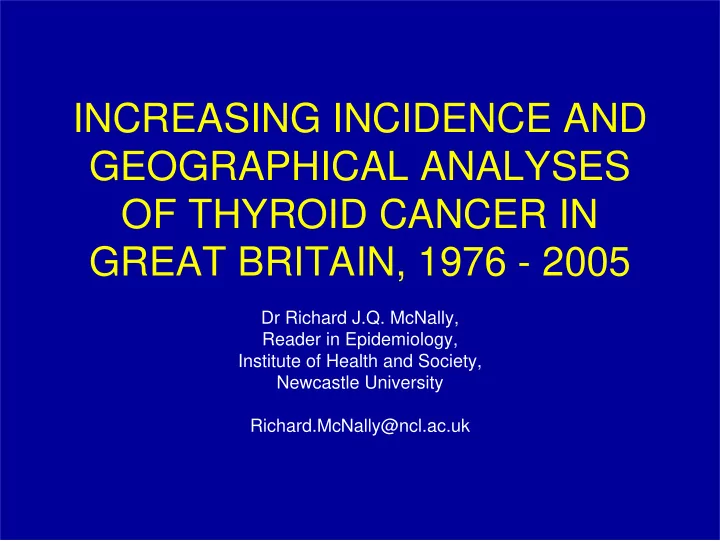

INCREASING INCIDENCE AND GEOGRAPHICAL ANALYSES OF THYROID CANCER IN GREAT BRITAIN, 1976 - 2005 Dr Richard J.Q. McNally, Reader in Epidemiology, Institute of Health and Society, Newcastle University Richard.McNally@ncl.ac.uk
INTRODUCTION (1) • Exact aetiology of thyroid cancer not known • Exposure to ionizing radiation in early life is a risk factor in children & young people • Can be a risk even at low levels
INTRODUCTION (2) • The nuclear accident in Chernobyl on 26 th April 1986 released a radioactive cloud • Reached northern England on 2 nd May 1986 • Increases in incidence (after accident) reported in other parts of Europe & USA
INTRODUCTION (3) • Statistically significant increase in incidence in 0 – 24 year olds from northern England during post-Chernobyl period (1987 – 2005) previously found • Increase was notably high in Cumbria
INTRODUCTION (4)
OBJECTIVES (1) • To examine temporal trends & geographical variation in the incidence of primary thyroid cancers using an extended age-range & geographical area of Great Britain, diagnosed 1976–2005 • 0–49 year olds • Northern England + Scotland + Wales
AIMS • (1) To analyse age, period & cohort effects • (2) To compare incidence between the pre- & post-Chernobyl periods (1976–1986 & 1987–2005) • (3) To analyse putative associations with area-based measures of deprivation & population density
METHODS (1) • Cases eligible for this study were all those diagnosed with primary differentiated (papillary or follicular) thyroid carcinoma • Case data were obtained from four population-based regional registries in GB: Northern & Yorkshire, North West, Wales & Scotland
METHODS (2) • Cases were allocated to census small areas, allowing linkage to population data from the 1981, 1991 & 2001 censuses • Age-standardised rates (ASRs) & 95% confidence intervals (CIs) were calculated
METHODS (3) • An adaptation of the Clayton-Schifflers method was used to analyse age-period- cohort effects. Negative binomial regression was used as data were sparse • The following effects were analysed: age, sex, drift (linear trend), non-linear period & non-linear cohort
METHODS (4) • Relative risks (RRs) & 95% CIs were calculated for each geographical area • Negative binomial regression was used to examine the effects of area-based measures of deprivation & population density
RESULTS (1) • 4327 cases analysed • Males: ASR = 3.9 per million persons per year (95% CI 3.6–4.1) • Females: ASR = 12.5 per million persons per year (95% CI 12.0–12.9)
RESULTS (2) • For temporal trends the best fitting negative binomial regression model included: age ( P <0.001), sex ( P <0.001) & drift (linear trend, P <0.001) • Non-linear period ( P =0.42) & non-linear cohort ( P =0.71) were NOT statistically significant
RESULTS (3) • The most marked statistically significant increases were seen in the areas of: • North Yorkshire (RR=2.55; 95% CI 1.49– 4.36) • Hartlepool (RR=5.53; 95% CI 1.28–23.98) • North East Lincolnshire (RR=2.55; 95% CI 1.05–6.19)
RESULTS (4) • North Lincolnshire (RR=3.46; 95% CI 1.02 –11.77) • York (RR=4.28; 95% CI 1.29–14.15) • Cumbria (RR=2.89; 95% CI 1.47–5.67) • Caerphilly (RR=2.67; 95% CI 1.00–7.14) • Rhondda (RR=14.41; 95% CI 1.96– 106.07)
RESULTS (5) • The Scottish Borders (RR=3.64; 95% CI 1.42–9.33) • North Ayrshire (RR=2.76; 95% CI 1.06– 7.21) • North Lanarkshire (RR=2.82; 95% CI 1.51–5.28)
RESULTS (6) • There were statistically significant associations with: • Population density (RR for an increase of one person per hectare=1.016; P <0.001) • Deprivation (RR for an increase of one unit in the deprivation score=1.071; P <0.001)
CONCLUSIONS (1) • There has been a linear increase in the incidence of thyroid cancer which has led to a doubling of the number of cases diagnosed over a twenty year span • The reasons for this increase are not well understood, but it is consistent with findings from other countries
CONCLUSIONS (2) • Higher incidence of thyroid cancer was observed in a number of different geographical regions • Higher rates were also associated with urban living and greater deprivation, indicating that other environmental or lifestyle factors may play a role in aetiology
FURTHER WORK • Investigate the relationship between incidence of thyroid cancer and area- based level of caesium-137 deposition as measured in 1986
ACKNOWDGEMENTS • Financial support from the JGW Patterson Foundation & the North of England Children’s Cancer Research Fund is gratefully acknowledged
Recommend
More recommend